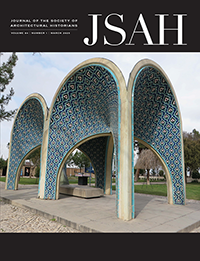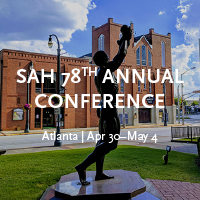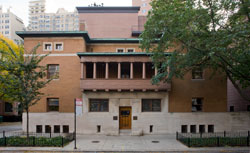-
Membership
Membership
Anyone with an interest in the history of the built environment is welcome to join the Society of Architectural Historians -
Conferences
Conferences
SAH Annual International Conferences bring members together for scholarly exchange and networking -
Publications
Publications
Through print and digital publications, SAH documents the history of the built environment and disseminates scholarshipLatest Issue:

-
Programs
Programs
SAH promotes meaningful engagement with the history of the built environment through its programsMember Programs
-
Jobs & Opportunities
Jobs & Opportunities
SAH provides resources, fellowships, and grants to help further your career and professional life -
Support
Support
We invite you to support the educational mission of SAH by making a gift, becoming a member, or volunteering -
About
About
SAH promotes the study, interpretation, and conservation of the built environment worldwide for the benefit of all
Membership grants you access to exclusive resources and programs and provides support for new research and programs. Compare benefits across all our membership levels and choose the membership level that works for you.
Every Member Receives
- A yearlong subscription to the Journal of the Society of Architectural Historians (JSAH). Choose from digital access only or a combined print and digital subscription.
- On-demand access to the complete JSAH Archive (1941–present)
- Member rates for registration to SAH’s Annual International Conference
- AIA CES credits earned through conferences and study tours
- Eligibility to apply for SAH grants and fellowships
- Access to members-only lectures, virtual meetups, and more
- Connection to peers through 12 topic-focused SAH Affiliate Groups
- Access to more than 200,000 images of the built environment through the SAHARA database
- Access to SAH Commons online scholarly network
- Discount of 50% on JSTOR access with JPASS
- Eligibility to serve on the SAH Board or committees
- Subscription to the SAH Newsletter and Opportunities Weekly Roundup
Membership Levels
SAH Member
Our most popular membership tier offers optimized pricing to help everyone participate affordably in our community. Emerging scholars can apply for a one-year membership grant that helps bridge the gap between the Society's subsidized student memberships and full-cost SAH memberships.
| Rate | Description | Price: Digital | Price: Digital + Print |
| Individual | 12-month benefits for one person | $163 | $173 |
| Joint | 12-month benefits for two people (domestic partners). Each person receives a unique member ID and their own login to the member portal. | $233 | $243 |
| Retired/Emeritus | Discounted individual membership for former professionals on a fixed income | $98 | $108 |
| Reduced | Discounted individual membership for people working independently or at an institution without full-time employment. This includes adjunct and contingent faculty unemployed workers. | $98 | $108 |
| Student | Discounted individual membership for students currently enrolled in an undergraduate or graduate program in architectural history or related disciplines. | $60 | $70 |
| Professional Associate | Discounted individual memberships for groups of professionals working in the same museum, office, or firm. Ideal for architects, research or preservation groups, museum staff, and public design education. | $179 for first member + $103 for each additional member at the same institution | |
Upper-Level Member
Show your support for SAH’s mission by including a tax-deductible donation along with your Individual or Joint print + digital membership. Upper-level members receive all the benefits of a regular membership plus:
- Discount on registration for SAH Annual Conference, rates given below.
- Acknowledgement in four quarterly issues of JSAH, the annual report, and quarterly donor reports
- Membership to Frank Lloyd Wright National Reciprocal Sites Program, with which our headquarters, the Charnley-Persky House is affiliated.
- Early registration access for SAH Study and Excursion tours
| Tier | Donation | Price with Individual Membership | Price with Joint Membership | Discount on Annual Conference Registration |
| Cornerstone | $150 | $323 | $393 | 5% |
| Pillar | $350 | $523 | $593 | 7% |
| Keystone | $500 | $673 | $743 | 8% |
Life and Benefactor Member
Show your long-term commitment to SAH by becoming a Life member. Life members’ dues provide unrestricted funds to support the Society’s mission and continued opportunities for all members. Lock in your price and enjoy the most comprehensive suite of member benefits without the need to renew each year.
Life members receive these additional benefits:
- Acknowledgement in JSAH, annual report, and quarterly donor reports
- Membership to Frank Lloyd Wright National Reciprocal Sites Program, with which our headquarters, the Charnley-Persky House is affiliated.
- Early registration access for SAH Study and Excursion tours
- Specialty membership card
- Free tour of SAH's historic headquarters at the Charnley-Persky House in Chicago, IL
- One complimentary walking tour during SAH Annual Conference, reserved in advance, on a space-available basis.
- Free copy of an SAH Buildings of the United States book of your choice
Current Life Members can enhance their commitment to SAH by becoming a Benefactor through a $5,000 tax-deductible donation.
| Tier | Price | Donation Total |
| Life | $5,000 (one payment or four annual payments of $1,250) | None * |
| Benefactor | $10,000 | $5,000 |
* Life memberships are amortized over a period of 20 years and pay for annual benefits. There is no tax-deductible portion associated with Life membership.
President's Circle
SAH is immensely grateful to the many Life and Benefactor Members who continue to support the Society financially year after year. President’s Circle status recognizes the ongoing commitment these members show.
President’s Circle status is an annual distinction given to all Life and Benefactor members who make gifts to the Society of Architectural Historians totaling $1,000 or more during a given 12-month period. The status is applied to a donor as soon as they have achieved $1,000 in gifts within a single calendar year. The status is valid for 12 months from that date, and the date shall serve as an anniversary by which to renew their President's Circle status with one or more gifts totaling $1,000.
President's Circle members receive special benefits as thanks for their support:
- 10% discount on member-rate conference registration
- Recognition from the podium at SAH Celebrates annual gala
Limited-Access Affiliate
Affiliate membership permits an individual to participate in the activities of one or more SAH Affiliate Groups and the SAH Commons online scholarly network, without access to any other SAH benefits such as JSAH or discounted registration for conferences. Price is $25 per year.
Institutional Subscription
Institutional membership provides a subscription to JSAH and/or JSAH Online for communities of readers at public and academic libraries, museums, schools of architecture, architectural history departments, and other large institutions. Institutional subscribers receive the SAH Newsletter, qualify for discounted Career Center job ads, and member-rate registration for two library staff attending the SAH Annual International Conference.
The University of California Press handles institutional subscriptions on SAH's behalf. Visit the UC Press website to join or renew your Institutional subscription.
| Subscription Type | Price per Year | Additional Benefits |
|---|---|---|
| Digital Only | $693 | |
| Print + Digital - Domestic | $781 | |
| Print + Digital - International | $807 | |
| Sustaining | $881 |
|
Affiliate Groups
SAH Affiliate Groups are comprised of SAH members who share a common, narrowly defined interest, scholarly or otherwise. Participation in Affiliate Group activities is a benefit of SAH membership.
SAH Chapters
SAH has chapters located across the United States. Chapters are independently run organizations that are affiliated with SAH. SAH members can join chapters in their region.
Member Stories
Member Stories: Destiny Kirumira
Jul 24, 2023
by
SAH News

Destiny Kirumira is a PhD student in the Peter Guo-hua Fu School of Architecture at McGill University. She lives in Montreal, and has been a member of SAH since 2021.
Can you tell us about your career path?
After receiving a Bachelor of Arts in Mathematics and Physics from the University of Alberta in 2018, I completed my Master of Architecture at the University of Calgary in 2021. I am currently completing my Ph.D. in Architecture at McGill University, which centers on the architecture of Black settlements in western Canada. My research attempts to reconcile the roots of racism which have limited research on the contributions of Black people in the field. Since being at McGill, I have been awarded the Inaugural Indigenous and Black Engineering and Technology Ph.D. Project (IBET) award, which has opened up doors to so many amazing opportunities and connections. Since then, I have had the pleasure of meeting a plethora of other Black scholars within and surrounding our field who have supported my academic journey greatly.
What projects are you currently working on?
Now that I have completed my comprehensive examination, I will be focusing on visiting archives and conducting fieldwork. I want to give this research as much attention as possible and have tried not to overwhelm this time with too many additional projects. That being said, I will also be contributing a chapter to an upcoming book project on racism in universities and the impact of race on the design of university campuses. We are still in the early stages of the project, but I am looking forward to learning more about this topic and working with other incredible scholars on addressing these issues.
Do you have a particular memory of when you first became aware of the significance of architecture or when you knew you wanted to study it?
My upbringing taught me about the significance of architecture and the role it can play in people’s lives. I was born in Germany to Ugandan parents who both valued education. Growing up my parents made an effort to surround our family with people from as many walks of life as possible with different ethnic, religious, and socioeconomic backgrounds. This meant I saw some of the most dire and affluent living conditions during my younger years, and it framed how I saw space and the possibility of architecture’s inert power. By the time I was ten, I had seen more than a dozen spatial organizations of apartment living rooms, several ways of decorating that reflected people’s heritage, and the way religion can shape or alter the way we see even the most ordinary of spaces.
My awe for design and architecture only grew when I was fortunate enough to have a close family friend of mine be an architect whose work I greatly admired. Her modern church designs in a German landscape that was draped in Gothic cathedrals inspired me and left me wanting more. It was then that knew I wanted to study architecture and I have not changed my mind yet.
What is your biggest professional challenge?
Throughout my career, my biggest professional challenge has been the devaluation of lived experience and how it has been weaponized against me in an effort to underestimate my expertise. Professors and fellow colleagues have in the day-to-day discussion surrounding my research focus diminished or dismissed the insights that lie in my Black lived experience, and yet praised scholars who relied on the very same wealth of knowledge for their work. The field is still slow to recognize other forms of knowledge, and it has held us back until recently.
When and how did you become involved with SAH?
I became involved with the SAH at the beginning of my PhD, in the fall of 2021. My supervisor, Dr. Ipek Türeli, was the Chair of the Minority Scholars Affiliate Group and offered me the position of technical assistant to the affiliate group. Since then, I have been a member of the SAH and have just attended my first SAH conference this past spring.
Can you tell us about your work with the SAH Minority Scholars Affiliate Group?
As a technical assistant, I had the opportunity to see behind the curtain and learn what it means to run and organize an affiliate group at the SAH. Beyond running the communications of the affiliate, which included our newsletter, I also organized opportunities for our members to connect with each other through events hosted throughout the academic year. Our newsletters allowed me to see and curate the many new opportunities that were being created both inside and outside the SAH for our members. My position also allowed me an inside look at how governance works in the SAH and received advice from senior minority scholars on how to navigate the academic world. Though I have stepped down from the role to focus on my doctoral studies, I hope to continue supporting the affiliate group and all of its endeavours in the future.
Do you have a vision for how SAH should evolve in the future?
SAH needs a cultural shift beyond the inclusion or uplifting of its minority or marginalized members. I think many organizations over the past three years have implemented some structural maneuvers to try to balance the scales. The efficacy of these actions is still under review, and many would argue that they are simply not enough, and they would be right. But perhaps worse yet, is the urgent need for white folks to see the benefit of those who were or are sidelined, and not given opportunities finally having access to reaching their own potential. If this mental shift does not occur, then it will only be a matter of time until we revert to the decades of injustice we had before. Empathy, no matter how radical it is, is not enough. We must see the success of others to be our success. And for many marginalized groups, that has not been the case which means trust needs to be rebuilt.
What advice would you give to someone who wants to enter your field?
This may seem as though I am trying to evade the question, but I think the advice I would give would greatly depend on the person who is seeking advice and the extent to which I know them. Moreover, all I can really provide them is largely based on what I have experienced, and perhaps to some extent, the advice others who have similar experiences as mine, would have advised.
The only advice I can impart is to protect at all costs the very idealistic, impassioned, and perhaps even naïve reason you entered the field in the first place. Above all else, this must be your prized possession, to fuel what it is that excited you about the material and architectural landscape we live in. I know of many "would-have-been-architects" who have made the decision to move to the study of buildings instead of the designing of them: a decision, I cannot say I have fully succumbed to quite yet. Most of them often cite an inability to draw, a disinterest in the design process itself, or a mere fascination with a building or site's historical background as the reasons they don’t regret this decision. But in the midst of securing teaching positions, publishing, securing funding, and somehow finding the energy to be a person, I find they can seldom remember the very reason their topic or building type captivated them in the first place. Don’t get me wrong, it is a human response to an atmosphere that often breeds burnout and demands hyper-productivity, but a younger version of each of us would be astounded by all we have learned and understood about the buildings that predate us and surround us. So, I would advise anyone who wants to enter your field to have a good reason to do so. And hold onto that feeling of wonder and excitement, because it can be fleeting.
Throughout my studies, I have been approached by many other Black women who either said they thought about doing architecture or studying buildings, but immediately felt inadequate or intimidated by the still largely white and male-dominated field. The inclusivity of marginalized populations into the academic sphere in our field has been a slow one, but one certainly worth the while. It’ll take some time for a Black woman like me to not be the only Black woman in my classes but by then I’ll be done with my PhD. But to the Black women I have encountered both preceding me in my studies and those who have yet to consider it, I would advise you to congratulate your achievements daily. If you have felt the sting of isolation, disdain for our "not white enough" topics or lack of support both in and outside our faculties, you’ll understand how there is a need to celebrate our steadfastness. Our big successes and triumph have only lately received more notoriety, but the daily tenacity needed to imagine yourself in a place you are not welcome and make that a reality, deserves our highest respect. We are due awards and accolades we may not receive or have yet to but let us celebrate all we have survived in the meanwhile.
And if somewhere you come across a young Black woman who is thinking about entering our field, tell her immediately that she belongs here. Sometimes we all need a little help imagining ourselves where we are yet to be.
SAH members engage with the history of the built environment through a broad array of specializations, professional fields, and areas of interest. Member Stories is a regular feature that recognizes the expertise and unique experiences of our members.

Membership Grants
Emerging scholars can apply for a one-year membership grant that helps bridge the gap between the Society's subsidized student memberships and full-cost SAH memberships.

